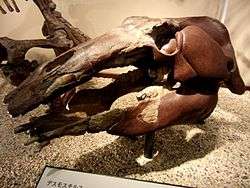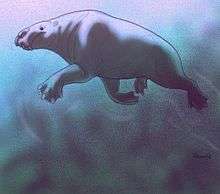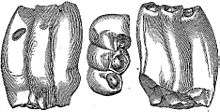Desmostylus
| Desmostylus Temporal range: Oligocene–Miocene | |
|---|---|
 | |
| Skull of D. japonicus at the National Museum of Nature and Science, Tokyo, Japan. Holotype | |
| Scientific classification | |
| Kingdom: | Animalia |
| Phylum: | Chordata |
| Class: | Mammalia |
| Order: | †Desmostylia |
| Family: | †Desmostylidae |
| Genus: | †Desmostylus Marsh 1888 |
| Species | |
| |
| Synonyms | |
| |
Desmostylus[1] is an extinct genus of herbivorous mammal of the family Desmostylidae living from the Chattian stage of the Late Oligocene subepoch through the Late Miocene subepoch (28.4 mya—7.250 Mya) and in existenced for approximately 21.2 million years.[2]
Morphology


Desmostylus was a large, hippopotamus-like creature of about 1.8 metres (6 ft) long which weighed about 200 kilograms (440 lb). It had a short tail and powerful legs with four hooves. Both the creature's jaws were elongated and sported forward-facing tusks, which were elongated canines and incisors.[3]
Most likely fully aquatic, Desmostylus is thought to have lived in shallow water in coastal regions. Recent isotope work indicates that Desmostylus more likely lived (or spent a large amount of time) in freshwater or estuary ecosystems foraging for aquatic freshwater plants.[4]
Species
D. hesperus (synonyms and invalid names: D. watasei, D. cymatias, D. californicus, D. mirabilis, D. minor, Desmostylella typica),[2] D. coalingensis (syn. Vanderhoofius coalingensis),[5][6] and D. japonicus.
Marsh 1888 named the type specimen D. hesperus based on a set of isolated teeth that he had found near Mission San Jose, California (type locality: 37°36′N 121°54′W / 37.6°N 121.9°W, paleocoordinates 36°48′N 117°36′W / 36.8°N 117.6°W).[7] Marsh described his specimen as a sirenian and proposed affinities with Metaxytherium (a genus of extinct dugongs) and Halicore (an obsolete name for dugong).[8]
Several other species were later described based on minor differences in tooth morphology. Most or all of these species have been synonymized with D. hesperus since variation in tooth morphology between individuals assigned to one of these species has proven to be to greater than the differences between species.[9]
D. japonicus was described by Yoshiwara & Iwasakai 1902 based on a well-preserved partial skull and named by Tokunaga & Iwasaki 1914. It has been reproposed as distinct species based on cranial morphology.[9]
Fossil distribution
Fossils have been discovered from along the northern Pacific Rim from Baja California Peninsula northward along the coast of California, Oregon, Washington and west to Sakhalin Island, Hokkaido, Japan, and south to the Shimane Prefecture, Japan.[2]
Notes
| Wikimedia Commons has media related to Desmostylus. |
- ↑ "Bound pillar", from Greek δεσμός (desmos), bond, and στῦλος (stulos), pillar, referring to the shape of the molars.
- 1 2 3 Desmostylus in the Paleobiology Database. Retrieved March 2013.
- ↑ Palmer 1999, p. 228
- ↑ Clementz, Hoppe & Koch 2003
- ↑ Tomida & Ohta 2007, p. 60
- ↑ Inuzuka, Domning & Ray 1984
- ↑ "Mission San Jose, east (Miocene of the United States)". Fossilworks. Retrieved December 2013. Check date values in:
|access-date=(help) - ↑ Marsh 1888, p. 96
- 1 2 Uno & Kimura 2004, p. 1
References
- Clementz, Mark T.; Hoppe, Kathryn A.; Koch, Paul L. (2003). "A paleoecological paradox: the habitat and dietary preferences of the extinct tethythere Desmostylus, inferred from stable isotope analysis". Paleobiology. 29 (4): 506–519. doi:10.1666/0094-8373(2003)029<0506:APPTHA>2.0.CO;2. OCLC 211272891.
- Inuzuka, Norihisa; Domning, Daryl P.; Ray, Clayton E. (1984). "Summary of taxa and morphological adaptations of the Desmostylia". Island Arc. 3 (4): 522–537. doi:10.1111/j.1440-1738.1994.tb00131.x.
- Marsh, O. C. (1888). "Notice of a new fossil sirenian, from California". American Journal of Science. 25 (8): 94–96. OCLC 79838746. Retrieved December 2013. Lay summary (December 2013). Check date values in:
|access-date=(help) - Palmer, Douglas (1999). The Marshall Illustrated Encyclopedia of Dinosaurs and Prehistoric Animals. London: Marshall Editions. ISBN 1-84028-152-9. OCLC 313633743.
- Reinhart, Roy Herbert (1959). "A review of the Sirenia and Desmostylia". University of California Publications in Geological Sciences. 36 (1): 1–146. OCLC 3474601.
- Tokunaga, S.; Iwasaki, C. (1914). "Notes on Desmostylus japonicus" (PDF). Retrieved December 2013. Check date values in:
|access-date=(help) - Tomida, Yukimitsu; Ohta, Toshikazu (2007). "Discovery of a desmostylian tooth from Kitami City, northeastern Hokkaido, Japan" (PDF). Memoir of the Fukui Prefectural Dinosaur Museum. 6: 57–61. Retrieved December 2013. Check date values in:
|access-date=(help) - Uno, Hikaru; Kimura, Masaichi (2004). "Reinterpretation of some cranial structures of Desmostylia hesperus (Mammalia, Desmostylia): A new specimen from the Middle Miocene Tachikaraushinai Formation, Hokkaido, Japan" (PDF). Paleontological Research. 8 (1): 1–10. doi:10.2517/prpsj.8.1. Retrieved December 2013. Check date values in:
|access-date=(help) - Yoshiwara, S.; Iwasaki, J. (1902). "Notes on a New Fossil Mammal" (PDF). Journal of the College of Science, Imperial University, Tokyo, Japan. 16. Retrieved December 2013. Check date values in:
|access-date=(help)